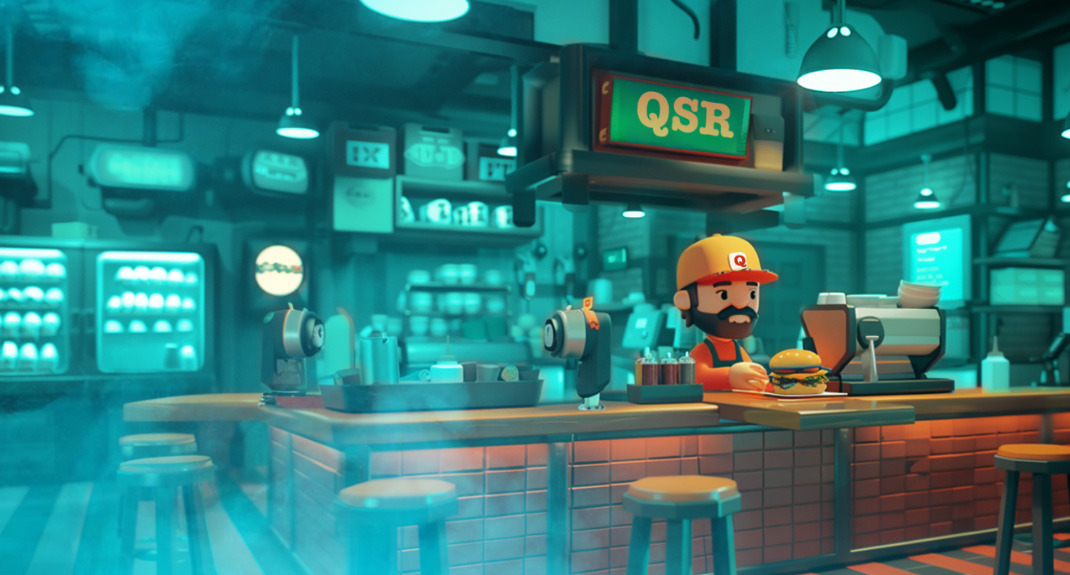- Newsroom
- >
- How Quick-Service Restaurants are Cooking Up Success In-Game

How Quick-Service Restaurants are Cooking Up Success In-Game
Ever felt hungry during a gaming session and needed to fuel up? If so, an ad for a mouthwatering burger or a refreshing Slurpee is sure to catch your eye. Now, imagine coming across one of these ads inside the game you’re playing, all without seeing your gameplay disrupted. This is an even better way to inspire your next choice of takeaway grub or delivery order.
Some of the world’s most popular quick-service restaurants (QSRs) are finding success by promoting their latest deals and products to gaming audiences. By strategically placing intrinsic in-game ads within popular titles to capture gamers’ attention, these brands are tapping into a large, highly engaged audience that is tailor-made for their offerings.
Let’s take a closer look at how in-game ads are proving to be a game-changer for the QSR industry, helping popular restaurant chains steer players towards their local storefronts or online promotional deals.
Why gamers are the ideal target audience for QSRs
The gaming industry has become a global phenomenon with an expansive and diverse audience. Gamers encompass a wide range of demographics, including various age groups, genders, and cultural backgrounds. There are currently over 3.3bn gamers worldwide, making up a substantial portion of the consumer market.
Gamers are also inherently digital consumers, spending significant amounts of time online. This already makes them easily reachable through games — many of which have integrated social features that foster a sense of community among players. Our research has found that socializing and new experiences are important to gamers, meaning that quick-service restaurants can effectively tap into this audience by becoming part of the gaming community.
As the name suggests, QSRs also thrive on providing fast and convenient dining options for consumers. This aligns well with gaming culture, where players are likely to enjoy quick and easy solutions that don’t get in the way of their gameplay experience.
Further exploring the connection
Our research has found that gaming audiences like to frequent quick-service restaurants in their spare time, suggesting that they enjoy the convenience and affordability of fast food and that they are likely to be interested in ads that promote the latest offerings or deals provided by these brands.
In the US, which has an estimated 202k QSRs across the country, 41% of gamers say they enjoy going to fast food restaurants as a top out-of-home activity. 68% also say they have eaten at a fast food or family restaurant in the past month, while 22% of gamers aged 18+ are also more likely to regularly order food through delivery services.
In the UK, which has around 46k QSRs, nearly half (49%) of gamers also say they enjoy stopping at their favorite takeaway joints.
How QSR brands have achieved in-game success
More QSR brands are seamlessly integrating themselves into the gaming experience, strategically placing intrinsic in-game ads into popular games to meaningfully capture the attention of players without disrupting their gameplay. We have worked with a roster of QSRs that have leveraged in-game ads to improve product reach and seen significant uplifts in brand awareness and favorability.
Popular convenience chain 7-Eleven, which provides numerous takeaway food options across their global storefronts, launched a campaign to promote a limited edition flavor of their signature Slurpee drink to Australian players in a bid to bring people back to their stores post-lockdown. After brand analysis revealed that their demographic of Slurpee loyalists mainly consisted of younger consumers, 7-Eleven went beyond conventional advertising channels and stepped into the world of gaming, running video and display ads via in-game ad placements across popular mobile titles.

After targeting players aged 13-44, the chain reached a total of 1m unique users and saw an 86% increase in top-of-mind awareness, as well as a 97% viewability rate. The cost per visit also went down to $0.19 for every user who visited the store.
QuikTrip, another popular US-based convenience chain, also launched an in-game campaign to drive awareness, using our geo-targeting capabilities to reach gamers aged 18+ across various cities and states. This allowed the chain to reach players who were located near their stores, keeping the brand top-of-mind across their key audiences.

Through a full year partnership, QuikTrip ran display and video ads within intrinsic in-game ad placements across 80+ premium gaming titles, routinely switching up their creatives to promote seasonal messaging and stay relevant with players. They reached a total of 3m unique users, achieving a 98% viewability rate and a 96% on-screen rate.
A well-known global sandwich chain also used in-game ads to increase brand awareness with German players, also running creatives across popular mobile titles. After launching the campaign, they saw a viewability rate of 85% and a 79% uplift in purchase intent. 80% of players also said they felt the ads stood out from the game.
QSRs and gamers: a great combo
The alignment between quick-service restaurants and gaming audiences presents a golden opportunity for these brands to connect meaningfully with target demographics — especially players who favor fast, convenient food solutions that, like many popular games, are easy and fun to digest.
With intrinsic in-game ads, QSRs can level up their marketing strategies and launch campaigns that add to the gameplay experience, allowing them to build lasting connections with an engaged and influential audience of players.
P.S. Whenever you’re ready, here are 4 ways we can support your in-game advertising journey:
- In-Game Guides - Explore in-depth guides that unpack the key areas of intrinsic in-game advertising.
- Monthly Updates - Stay ahead with our newsletter, featuring insights, updates, and tips for maximizing your campaigns.
- Real Results - See how leading brands are leveraging in-game technology by browsing our case studies.
- Expert Advice - Got questions? Drop us a message, and one of our team members will get back to you with insights or set up a time to chat.